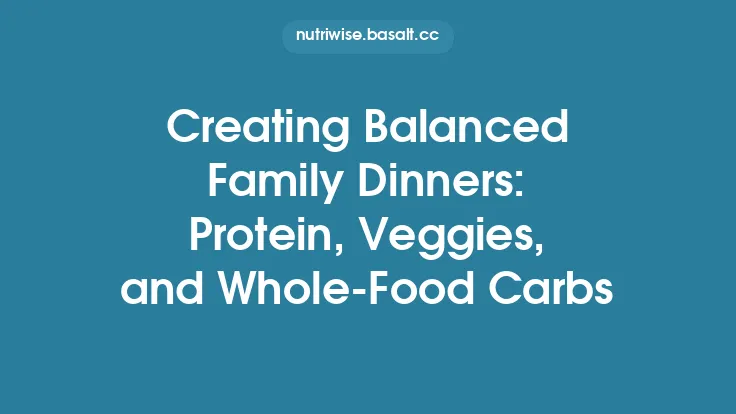When the workday stretches into the evening and the clock is already ticking, the idea of cooking can feel like an added stressor. Yet a well‑planned, five‑ingredient dinner can be the perfect antidote: it’s quick, requires minimal grocery shopping, and still delivers the nutrition and satisfaction you need after a long day. By focusing on a handful of high‑impact ingredients, mastering a few versatile techniques, and keeping a well‑stocked pantry, busy professionals can consistently bring a home‑cooked meal to the table without sacrificing time or flavor.
The Power of Simplicity – Why 5 Ingredients Work
- Reduced Decision Fatigue – Limiting the ingredient list forces you to choose items that truly matter, cutting the mental load of “what should I make tonight?”
- Streamlined Shopping – Fewer items mean fewer trips to the store and a lower grocery bill. Bulk‑buying staples (olive oil, soy sauce, canned tomatoes) further drives down cost.
- Focused Flavor Development – With fewer components, each ingredient’s taste shines. Proper technique (searing, caramelizing, deglazing) amplifies natural flavors, making a simple dish feel gourmet.
- Consistent Nutrient Balance – By pairing a protein, a vegetable, a healthy fat, a carbohydrate, and a flavoring agent, you can hit macro‑ and micronutrient targets without complex calculations.
Core Pantry Staples Every Professional Should Keep
| Category | Recommended Items | Why They Matter |
|---|---|---|
| Fats | Extra‑virgin olive oil, unsalted butter, avocado oil | High smoke‑point oils for searing; butter for finishing sauces. |
| Acids | Fresh lemons/limes, balsamic vinegar, apple cider vinegar | Brighten dishes, balance richness, and aid in quick marinades. |
| Seasonings | Sea salt, freshly cracked black pepper, dried herbs (thyme, oregano, rosemary), smoked paprika | Provide depth without extra ingredients. |
| Umami Boosters | Soy sauce or tamari, canned tomatoes (whole or crushed), miso paste, Parmesan rind | Add savory complexity in a spoonful. |
| Carbohydrate Bases | Quick‑cooking rice (e.g., jasmine), couscous, pre‑cooked quinoa, small potatoes | Cook in 10‑15 minutes, pair well with proteins. |
| Proteins (freeze‑able) | Skinless salmon fillets, pork tenderloin, shrimp (peeled), firm tofu, canned beans (chickpeas, black beans) | Versatile, long‑shelf life, and quick to cook. |
Keeping these items on hand means you can assemble a dinner in under 30 minutes with just a few fresh additions (e.g., a seasonal vegetable or a handful of fresh herbs).
Choosing the Right Protein – Quick Picks
| Protein | Cooking Method | Approx. Cook Time | Ideal Pairings |
|---|---|---|---|
| Salmon fillet | Pan‑sear → finish in oven | 12‑15 min | Lemon‑butter, asparagus, couscous |
| Pork tenderloin | Sear → roast | 20‑25 min | Apple‑maple glaze, green beans, roasted potatoes |
| Shrimp | Sauté in butter & garlic | 4‑6 min | Garlic‑herb butter, zucchini noodles, rice |
| Firm tofu | Press → pan‑fry | 8‑10 min | Soy‑ginger glaze, bok choy, quinoa |
| Canned chickpeas | Rinse → sauté | 5‑7 min | Curry powder, spinach, basmati rice |
When time is limited, opt for proteins that cook quickly (shrimp, tofu) or that can be partially pre‑cooked (canned beans). For larger cuts like pork tenderloin, a brief sear followed by a short oven roast yields a tender result without constant attention.
Five‑Ingredient Dinner Templates
Below are adaptable frameworks. Swap the highlighted ingredient to suit your palate or what’s on sale, and you’ll have a new dinner in minutes.
1. Pan‑Sear Salmon with Citrus Butter
Ingredients: Salmon fillet, unsalted butter, lemon, fresh dill (or dried dill), salt.
Method: Pat salmon dry, season with salt, and sear skin‑side down in a hot skillet with a thin layer of butter. Flip after 4 minutes, add a knob of butter, a squeeze of lemon juice, and dill. Spoon the melted butter over the fish and finish with a quick 2‑minute oven blast if the fillet is thick. Serve with a side of steamed broccoli or a simple grain.
2. Sautéed Pork Tenderloin with Apple‑Maple Glaze
Ingredients: Pork tenderloin, apple cider vinegar, pure maple syrup, smoked paprika, olive oil.
Method: Slice tenderloin into 1‑inch medallions. Season with smoked paprika and salt, then sear in olive oil until golden. Deglaze the pan with apple cider vinegar, add maple syrup, and reduce to a glossy glaze. Return pork to the pan for a final coat. Pair with quick‑steam green beans.
3. Shrimp & Garlic Herb Orzo
Ingredients: Large shrimp (peeled), orzo pasta, garlic cloves, fresh parsley, olive oil.
Method: Cook orzo according to package (usually 8‑10 minutes). Meanwhile, sauté minced garlic in olive oil, add shrimp, and cook until pink. Toss cooked orzo with shrimp, drizzle with a little more olive oil, and finish with chopped parsley. A squeeze of lemon adds brightness if desired.
4. Tofu with Soy‑Ginger Glaze
Ingredients: Firm tofu, soy sauce (or tamari), fresh ginger, honey, sesame oil.
Method: Press tofu to remove excess moisture, cut into cubes, and pan‑fry in sesame oil until crisp. In a small bowl, whisk soy sauce, grated ginger, and honey. Add the glaze to the pan, toss to coat, and let it thicken for a minute. Serve over quick‑cooking rice or a handful of snap peas.
5. Beef & Mushroom Skillet
Ingredients: Thinly sliced beef (e.g., sirloin), cremini mushrooms, butter, fresh thyme, black pepper.
Method: Heat butter in a skillet, sear beef quickly on high heat (2‑3 minutes) and set aside. In the same pan, add sliced mushrooms and thyme; sauté until mushrooms release their moisture and brown. Return beef, season with pepper, and stir‑fry for another minute. This dish pairs beautifully with a side of butter‑sautéed spinach.
6. Chickpea & Spinach Curry
Ingredients: Canned chickpeas, fresh spinach, canned diced tomatoes, curry powder, coconut milk (optional).
Method: Rinse chickpeas and set aside. In a saucepan, combine diced tomatoes and curry powder; simmer for 3 minutes. Add chickpeas and a splash of coconut milk (or water) and cook until heated through. Stir in spinach until wilted. Serve over a bed of couscous for a complete meal.
7. Baked Cod with Tomato‑Basil Relish
Ingredients: Cod fillets, canned crushed tomatoes, fresh basil, olive oil, salt.
Method: Place cod in a baking dish, drizzle with olive oil, and season with salt. Spoon crushed tomatoes over the fish, scatter torn basil leaves, and bake at 400 °F for 12‑15 minutes. The tomato sauce becomes a light, aromatic broth—perfect with a side of quinoa.
Technique Tips to Maximize Flavor with Minimal Ingredients
- High Heat Searing – A hot pan (≈ 200 °C/400 °F) creates the Maillard reaction, developing a caramelized crust that adds depth without extra sauces. Pat proteins dry before searing to avoid steaming.
- Deglazing – After searing, add a splash of acid (wine, vinegar, citrus) to dissolve browned bits (fond). This forms the base of a quick pan sauce.
- Finishing Butter – Swirling a knob of cold butter at the end of cooking emulsifies the sauce, giving it a glossy, velvety texture.
- Layered Seasoning – Salt early (during searing) to draw out moisture, then finish with a pinch of flaky sea salt for texture.
- Resting Proteins – Let cooked meat rest for 3‑5 minutes; juices redistribute, resulting in a juicier bite.
Time‑Saving Strategies for Busy Professionals
- Batch‑Prep Staples – Cook a large pot of rice or quinoa on Sunday; store in the fridge for up to 5 days.
- Pre‑Portion Proteins – Divide raw chicken, fish, or tofu into single‑serve bags; label with date and freeze. Thaw in the refrigerator overnight.
- Use the Microwave for Veg Prep – While the protein cooks, steam frozen mixed vegetables in the microwave (3‑4 minutes) and toss into the final dish.
- One‑Pan Cleanup Hack – Line pans with parchment or silicone mats; they can go straight into the dishwasher.
- Smart Kitchen Tools – A good quality non‑stick skillet, a digital thermometer, and a rapid‑boil kettle can shave minutes off each step.
Meal Prep and Storage for 5‑Ingredient Dinners
| Dish | Refrigerated Shelf Life | Freezer Compatibility |
|---|---|---|
| Seared salmon with butter sauce | 2 days (reheat gently) | Not recommended (texture changes) |
| Pork tenderloin with glaze | 3 days | Yes – freeze in airtight container, reheat in oven |
| Shrimp & herb orzo | 2 days | Yes – freeze, thaw, and reheat with a splash of broth |
| Tofu soy‑ginger | 4 days | Yes – freeze, texture becomes firmer (still tasty) |
| Beef & mushroom skillet | 3 days | Yes – freeze, reheat on stovetop |
| Chickpea spinach curry | 5 days | Yes – freeze, reheat on stovetop or microwave |
| Baked cod with tomato relish | 2 days | Not recommended (fish can become dry) |
When reheating, add a teaspoon of water or broth and cover the dish to retain moisture. For frozen meals, defrost overnight in the fridge for best texture.
Customizing for Dietary Preferences
- Vegetarian – Swap animal proteins for tofu, tempeh, or hearty legumes (lentils, chickpeas). The chickpea‑spinach curry and tofu‑soy glaze are already plant‑based.
- Gluten‑Free – Use rice, quinoa, or gluten‑free pasta alternatives. Ensure soy sauce is tamari (gluten‑free).
- Low‑Carb – Replace grains with cauliflower rice or spiralized zucchini. The salmon with citrus butter, pork medallions, and beef‑mushroom skillet work beautifully without a carb side.
- Paleo – Focus on animal proteins, non‑starchy vegetables, and healthy fats. Replace couscous or rice with roasted sweet potatoes (prepared quickly in a microwave‑safe bag).
Budgeting and Shopping Smart
- Buy in Bulk When Possible – Large bags of rice, beans, and frozen vegetables are cheaper per serving.
- Seasonal Produce – Choose vegetables that are in season; they’re less expensive and more flavorful.
- Store Brands – High‑quality store‑brand olive oil, butter, and canned tomatoes often match name‑brand taste at a fraction of the cost.
- Utilize the “5‑Ingredient” Rule at the Store – Scan your pantry list, then only add the fresh component(s) you need for the week’s meals. This prevents impulse buys.
- Track Waste – Keep a simple log of what you throw away. If you notice recurring items (e.g., extra herbs), adjust your shopping list accordingly.
Bringing It All Together
A five‑ingredient dinner isn’t a compromise; it’s a strategic approach that leverages high‑impact ingredients, efficient techniques, and thoughtful planning. By maintaining a well‑stocked pantry, mastering a handful of cooking fundamentals, and using the templates above, you can consistently deliver nutritious, restaurant‑quality meals in the time it takes to finish a work email. The result? More evenings spent enjoying food at the table rather than staring at a take‑out menu, and a healthier, more balanced lifestyle that fits the demands of a busy professional life.





